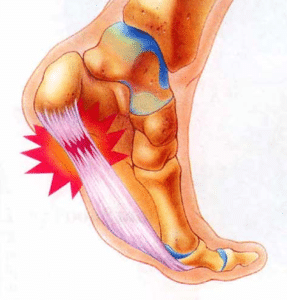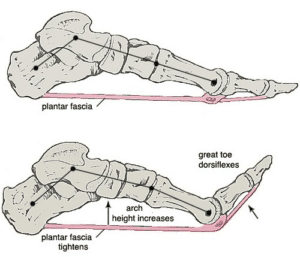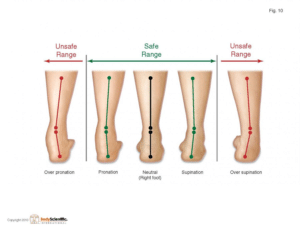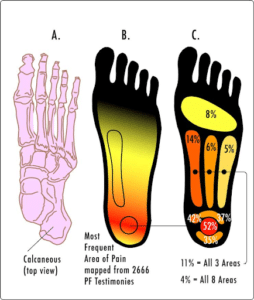What is Plantar Fasciitis?

The name “plantar fasciitis” implies inflammation of the plantar fascia. However, most cases are not necessarily inflammatory conditions. Plantar fasciitis can also be commonly misdiagnosed. It takes a licensed physical therapist to examine the differential diagnoses and determine the root cause of the dysfunction.
What is the Plantar Fascia?
The plantar fascia is a long and thin band that originates on the heel. It extends to the surface of the foot. The function is to create tension that adds strong stability to the arch of the foot. When the great toe extends the plantar fascia becomes tightened. This in turn elevates the arch and provides stability to the foot.2

What are the most common symptoms of plantar fasciitis?
- Typically the pain is located closer to the heel
- Increased pain in the morning when taking first few steps
- More painful after prolonged sitting when taking first few steps
- Symptoms improve throughout the day as the body warms up/stretches
- Increased pain after exercise
What are the most common risk factors for plantar fasciitis?
- High arches
- Excessive foot pronation
- Tight calf muscles
- Limited toe extension
- Unable to raise the foot upward towards the shin
- Repetitive impact activities (tennis, running, basketball, etc.)
- Poor shock absorption or single-leg stability
- Middle age with slightly higher prevalence in women

Plantar fasciitis and running
- Plantar fasciitis is a common condition in the athletic population, especially in runners. It makes up 8-10% of all running related injuries.3 The plantar fascia plays a big role in shock absorption during all impact and weight bearing activities. In fact, the plantar fascia and adjacent fat pad are responsible for absorbing up to 110% of body weight during walking and 250% during running. It is important to seek treatment if you are experiencing pain while running due to the risk of it becoming a chronic condition if left untreated.
Is plantar fasciitis treatable?
Typical treatment plans at Symmetry Physical Therapy include high load strength training, calf stretching, ankle dorsiflexion mobilizations, great toe extension, and intrinsic foot strengthening. Posterior-night splints can be used in the short term, but should not replace the need for strengthening and stretching.
If you are experiencing plantar fasciitis related pain, it is always best to have a full evaluation performed by a physical therapist to develop a personalized plan of care. Check out Symmetry Physical Therapy’s Instagram for videos of some exercises to get you started!
Conclusion
Are you dealing with body aches related to activity or exercise? We are here to help! At Symmetry, we will provide you with a physical therapy assessment to get to the root cause of your pain. Check out our Youtube channel for more tips and easy to follow exercises videos.

